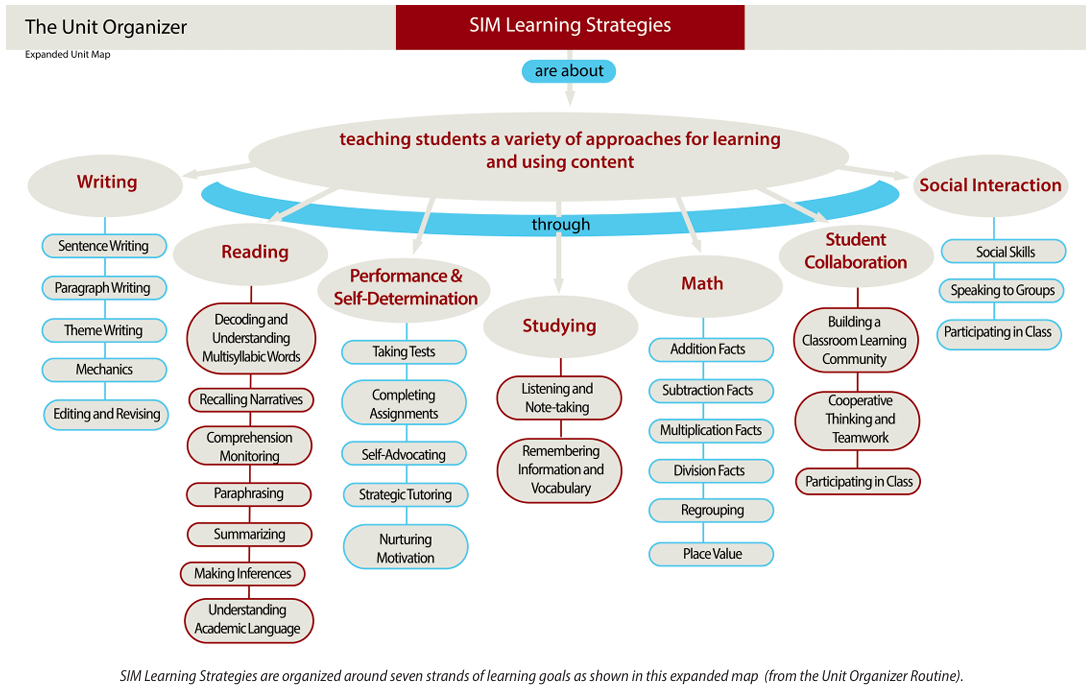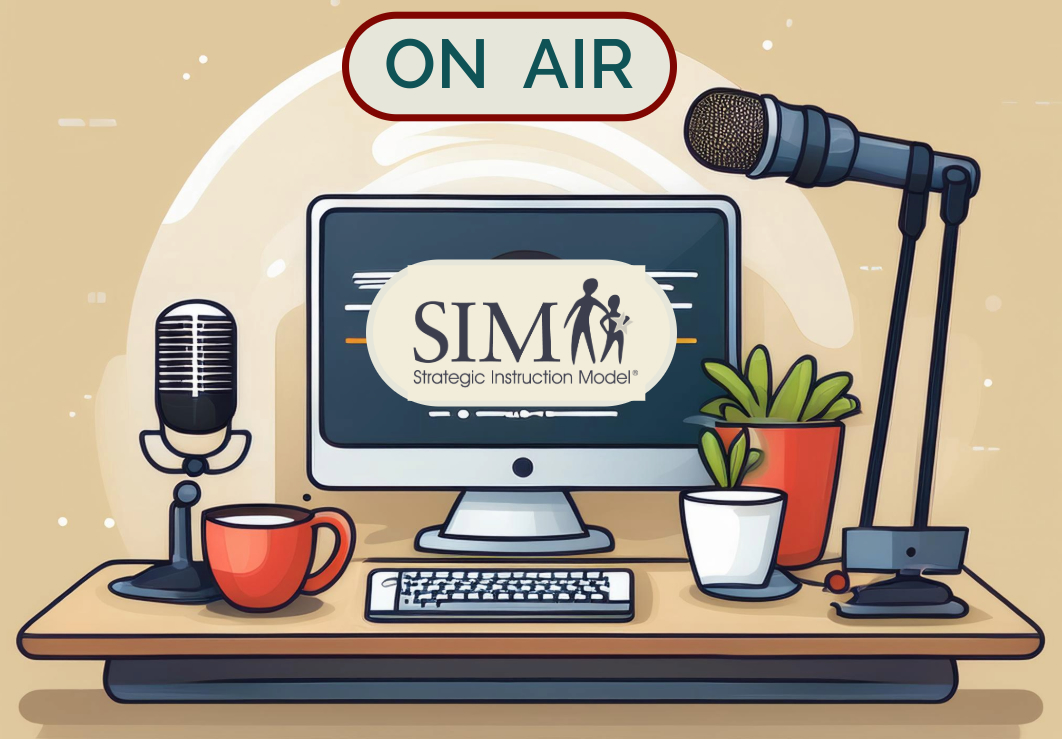SIM Learning Strategies

Building Literacy Skills for all Learners
SIM encompasses more than 50 specific Learning Strategies that can help students overcome specific learning difficulties that impede literacy, from identifying words in text to completing assignments on time to writing complete essays.
Students use SIM Learning Strategies to help them understand information and solve problems. Students who do not know or use good learning strategies often learn passively and ultimately fail in school. SIM Learning Strategy instruction focuses on making students active learners.

SIM writing strategies help students express themselves. These strategies help students write sentences, paragraphs, and themes and monitor their work for errors. LEARN MORE
- EDIT Strategy
- Error Monitoring Strategy
- Fundamentals in the Sentence Writing Strategy
- Fundamentals in the Theme Writing Strategy
- InSPECT Strategy
- Multi-Media Based Writing Strategies
- Paragraph Writing Strategy
- Proficiency in the Sentence Writing Strategy
- Proficiency in the Theme Writing Strategies
- Star Writer Program (Paragraph & Theme Writing)
- Writing Mechanics Programs (Capitalization, Commas, Punctuation)
Additional Resources:
One line of SIM Learning Strategies concentrates on helping students improve their reading abilities. It includes strategies for learning how to paraphrase critical information, picture information to promote understanding and remembering, ask questions and make predictions about text information, and identify unknown words in text. LEARN MORE
These Learning Strategies help students study information once they acquire it. They include strategies for developing mnemonics and other devices to aid memorization of facts as well as strategies for learning new vocabulary. These strategies help prepare students for tests. LEARN MORE
SIM Learning Strategies related to performance and self-determination help students set goals, complete daily assignments, and confidently approach and take tests. LEARN MORE
The SIM math strategies cover everything from addition to division. They use a concrete-representational-abstract method of instruction to help students master math. LEARN MORE
- Addition Facts 0 to 9
- Addition Facts 10 to 18
- Addition with Regrouping
- Addition within 20
- Division Facts 0 to 81
- Multiplication Facts 0 to 81
- Multiplication with Regrouping: Partial Products
- Multiplication with Regrouping: Standard Algorithm
- Place Value: Discovering Tens and Ones
- Subtraction Facts 0 to 9
- Subtraction Facts 10 to 18
- Subtraction with Regrouping
SIM includes several series that help students participate effectively in class, work together in teams, organize their desks or lockers, and interact with each other. LEARN MORE
- Community Building Series - Developed as a part of the “safe schools” movement, the series was designed to help students learn important skills that can turn every classroom into a true learning community. Within a learning community, all students are sincerely interested in one another and actively work to help each other learn. All members feel valued for what they can contribute. They feel safe and protected, and they are able to take risks as learners. They feel connected to one another. As a result, negative interactions and bullying are minimized, and students who need help and support can receive it within the structure of the class. In this series, students learn confidence and competence-building skills associated with participating and working with partners and the concepts of respect, tolerance, and a learning community.
- Cooperative Thinking Strategies - A group of strategies students can use to think and work productively together. These instructional programs provide ways to accommodate a diversity of learners in inclusive classrooms and enable students to learn complex higher-order thinking skills that they can use to work together harmoniously with others in school, leisure, family, community, and work setting.
- SLANT: A Starter Strategy for Class Participation - available for FREE download
A significant number of youth struggle with social adjustment issues. Research shows that these problems are not only common but also persistent, often escalating from minor behavioral concerns to criminal activity. Such issues are typically resistant to change and are linked to poor psychological and emotional outcomes later in life. Given the prevalence of antisocial behavior in both schools and communities, it is essential to implement effective strategies that address the social development needs of young people. While many schools have introduced safety measures—such as metal detectors and on-site police officers—and launched anti-bullying campaigns to improve peer interactions, these efforts may not be enough. Considering the potentially severe consequences of social maladjustment and its strong correlation with future criminal behavior, more intensive, individualized interventions are often necessary. LEARN MORE
John may be enrolled in 7th grade science, but how is he going to succeed when he can only read at the second grade level? By using the “Teaming Techniques,” educators and other adults can support students like John, both academically and socially within the general education curriculum.
For educators working with other educators, one of the first steps is to develop a collaborative relationship. Thus, using the Collaborative Problem Solving program, special education and general education teachers can communicate with one another, solve problems, make decisions, and create plans to help students like John succeed in inclusive classrooms.
Family members and educators can also team together to support students by using the Progress Program. In this approach, students carry a modified report card between home and school. At school, teachers check the card and note rules broken, rules obeyed, and academic progress. At home, parents review the card, praise improved performance, and provide home privileges based on the report card.
Finally, personal problems that may not even relate to school may affect students like John. “My brother was arrested, and he was helping me study for my tests.” “My dad won’t let me try out for football.” “My family needs money, and I can’t find a job.” Problems like these can interfere with learning. Surface Counseling is a simple procedure educators and other adults can use when students approach them with such problems.
Please note that professional development, coaching, and infrastructure support are essential components to effective implementation of SIM instructional tools and interventions. It is highly recommended that you work with a SIM professional developer. Email simpd@ku.edu to learn more.
